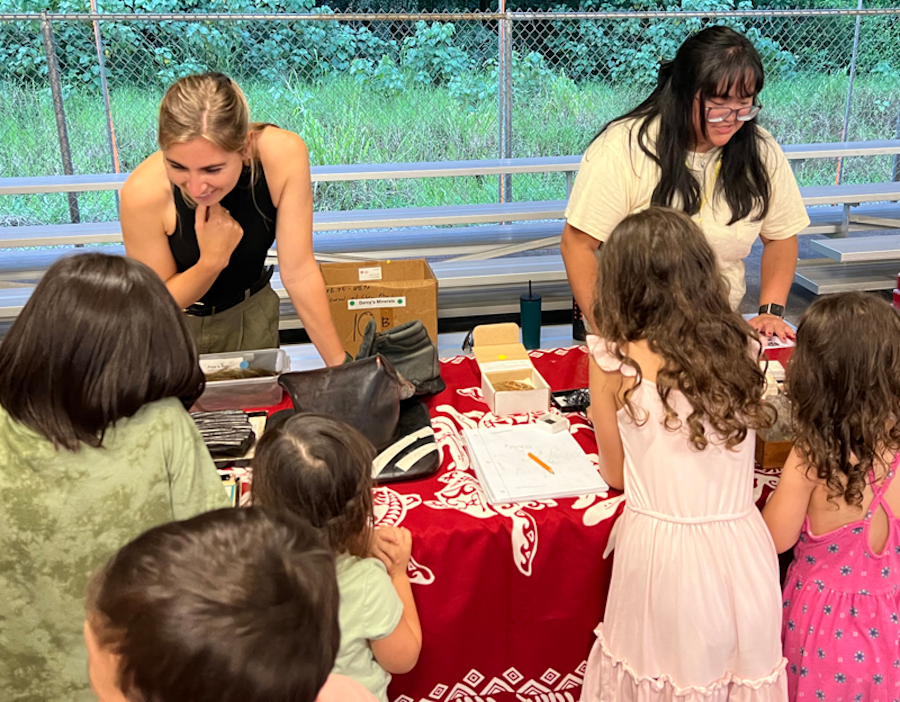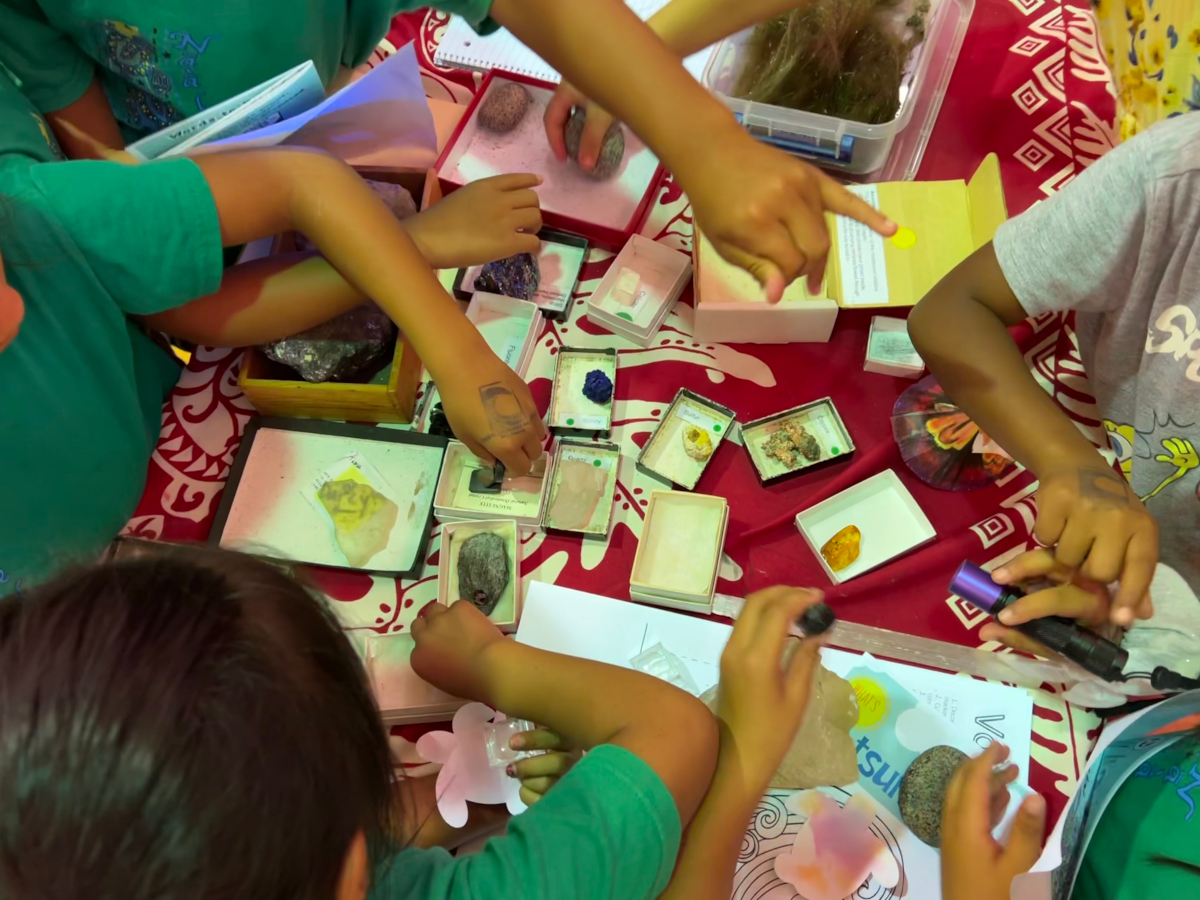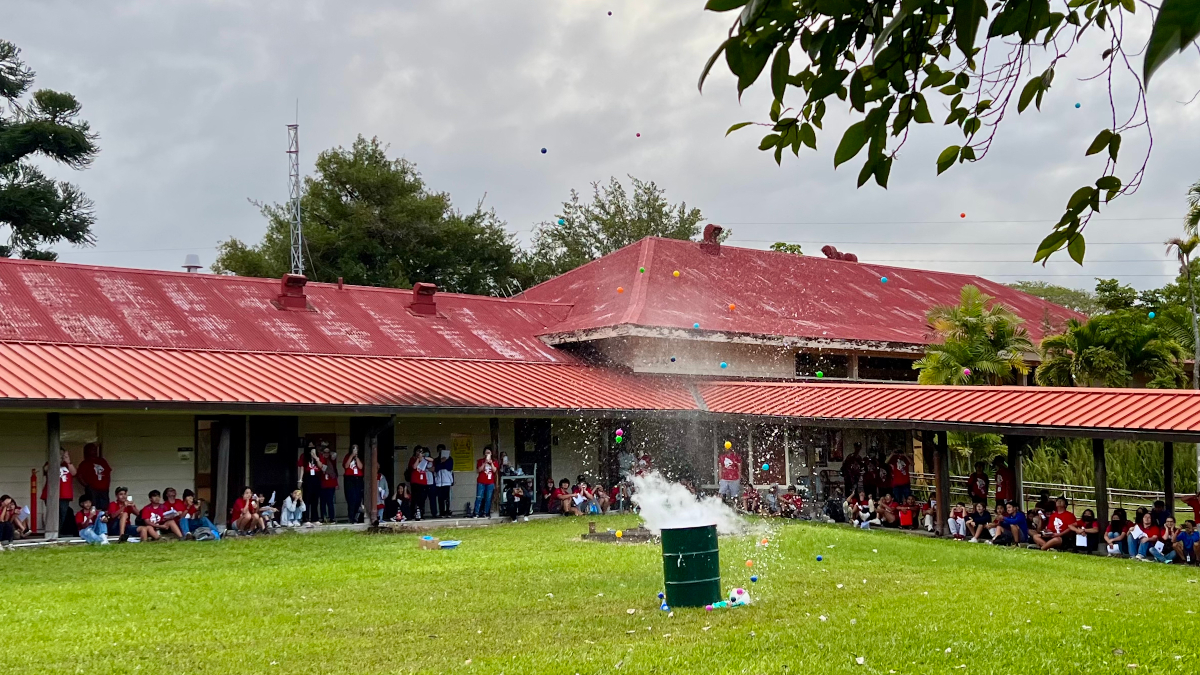
USGS: “CSAV staff Meghann Decker and UH Hilo Geology Alumni Sadie Nguyen talk with children at a Science Night at E.B. DeSilva.” (UH Hilo photo by Darcy Bevens)
(BIVN) – Kīlauea volcano is not erupting and remains at an alert level of ADVISORY. The unrest southwest of Kīlauea’s summit continues, with low levels of seismic activity.
Scientists with the USGS Hawaiian Volcano observatory continue to say that while there is currently no sign of an imminent eruption, eruptive activity is still possible in the coming weeks or months.
In the latest USGS Hawaiian Volcano Observatory Volcano Watch, scientists wrote about “fostering prepared youths on the natural hazards of backyard volcanoes.”
This week’s article is by Center for the Study of Active Volcanoes staff Darcy Bevens and Meghann Decker:
During volcanic crises, the USGS Hawaiian Volcano Observatory (HVO) plays a pivotal role, sharing information on activity and associated hazards with close partners on the Island of Hawai‘i, including the Mayor’s Office, the Hawaii County Civil Defense Agency, Hawaiʻi Volcanoes National Park, and the Hawaii Emergency Management Agency.
During non-crisis periods, HVO maintains a range of lesser-known partnerships with state and county agencies. One noteworthy collaboration is with the University of Hawaiʻi at Hilo (UH Hilo) and the Center for the Study of Active Volcanoes (CSAV). Beyond its contributions to CSAV’s International Training Program (International Volcano Scientist Training Course Returns to Hawaii July 6 2023), the USGS Volcano Hazards Program upholds a cooperative agreement with UH Hilo and CSAV. This agreement facilitates UH Hilo students’ involvement in working alongside HVO scientists and technical teams dedicated to monitoring Hawaii’s volcanoes. Furthermore, it supports an active hazards outreach program geared towards educating Hawaii’s keiki (children) about our natural hazards and the importance of preparedness.
To fulfill this educational mission, CSAV launched an array of public outreach programs in the early 1990s, which included community seminars, teacher training workshops, and school visits across the Island of Hawaiʻi. CSAV quickly recognized the eagerness of schoolchildren to learn about natural hazards, particularly enjoying hands-on demonstrations such as the tsunami wave tank and baking soda volcano. CSAV’s outreach endeavors even extended to preschools, adhering to the adage, “If you plan for a year, plant kalo. If you plan for ten years, plant koa. If you plan for 100 years, teach the children.”

USGS: “Nāʻālehu Elementary School keiki explore different properties of rocks and minerals at the grand opening of the Honuworks Robotic Center.” (UH Hilo photo by Meghann Decker)
One of CSAV’s goals is to educate the general public on hazards associated with volcanoes, earthquakes, and tsunamis. This education encompasses both the scientific aspects of these hazards and strategies for mitigating risk. CSAV emphasizes educating children and adolescents of Hawaii nei about the importance of emergency kits, evacuation plans, and effective communication during disasters. This cultural shift towards preparedness can save lives and reduce damage during hazardous events.
The COVID-19 pandemic necessitated suspending face-to-face school visits. However, CSAV staff are happy to have recently resumed in-person public outreach through classroom visits and community events. HVO remains steadfast in its commitment to monitoring volcanoes in Hawaii, gathering data, assessing potential hazards, and disseminating information to relevant agencies and the public. Working in tandem, CSAV emphasizes the importance of educating the younger generation. By engaging and educating youths on volcanic hazards, we can create a more resilient and informed community prepared to respond to and mitigate the impact of these events.
While teaching natural hazards to schoolchildren, CSAV staff noted that students exhibited a strong interest in science and local geology. Consequently, the outreach program expanded to include educational sessions for school groups on rocks and minerals, with a specific focus on Hawaiian volcanic products like pāhoehoe, pumice, and Pele’s Hair. Students are encouraged to consider STEM (Science, Technology, Engineering, Math) courses, and, at events such as Career Day for high school groups, they are recommended to explore science programs at UH Hilo and Hawaii Community College.
CSAV efforts are supported by the UH Hilo Geology department, who facilitate mentorship to science fair participants and visiting schools. They expose students to analytical equipment and spectacular demonstrations such as the Trashcano, a simulated volcanic eruption with a 50-gallon trash can and liquid nitrogen.
Working together, HVO, CSAV, and UH Hilo educate and inform Island of Hawaiʻi kamaʻāina. We hope to better prepare people of all ages, from keiki to tutu, for the range of natural hazards associated with volcanoes in our backyard that can potentially impact them. Look for CSAV at upcoming community events such as career days, Girl Scouts STEM, the West Hawaii Exploration Fair, and school science nights.
To learn more, please visit the CSAV outreach page for more information.


by Big Island Video News4:31 pm
on at
STORY SUMMARY
HAWAIʻI - The weekly article details the active hazards outreach program geared towards educating kids about the importance of preparedness.